Lifestyle
Children are stuck inside, glued to screens. Are 'forest schools' the antidote?
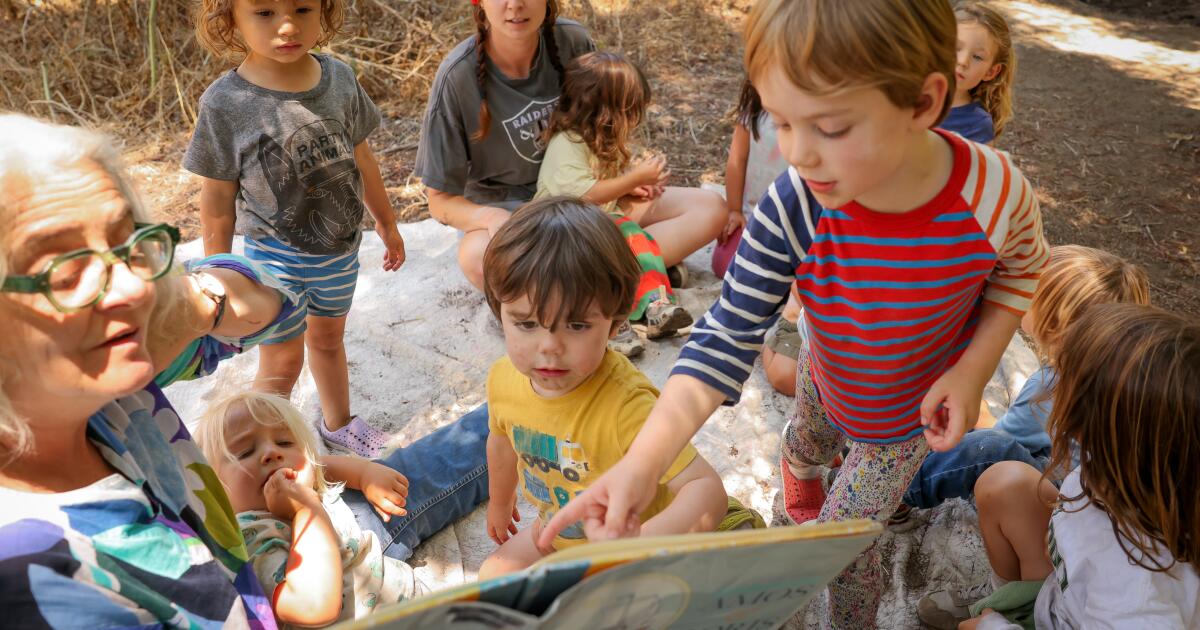
On a glorious summer day, a preschooler named Roger teetered on rocks dotting a creek in eastern Orange County, unsure if he could make it back to where his classmates and caregivers were waiting.
A volunteer youth mentor with Earthroots Field School stuck out her hand, reassuring the 3-year-old, who grasped it and took one confident step toward her. Then another. “There we go!” someone called out as he cleared the burbling waterway.
Pushing edges — like learning to balance on rocks without a parent swooping in — is a central tenet of nature-based education, according to Angela Capps, a teacher at the school, one of a rapidly growing number of early education providers that are centered around the natural world.
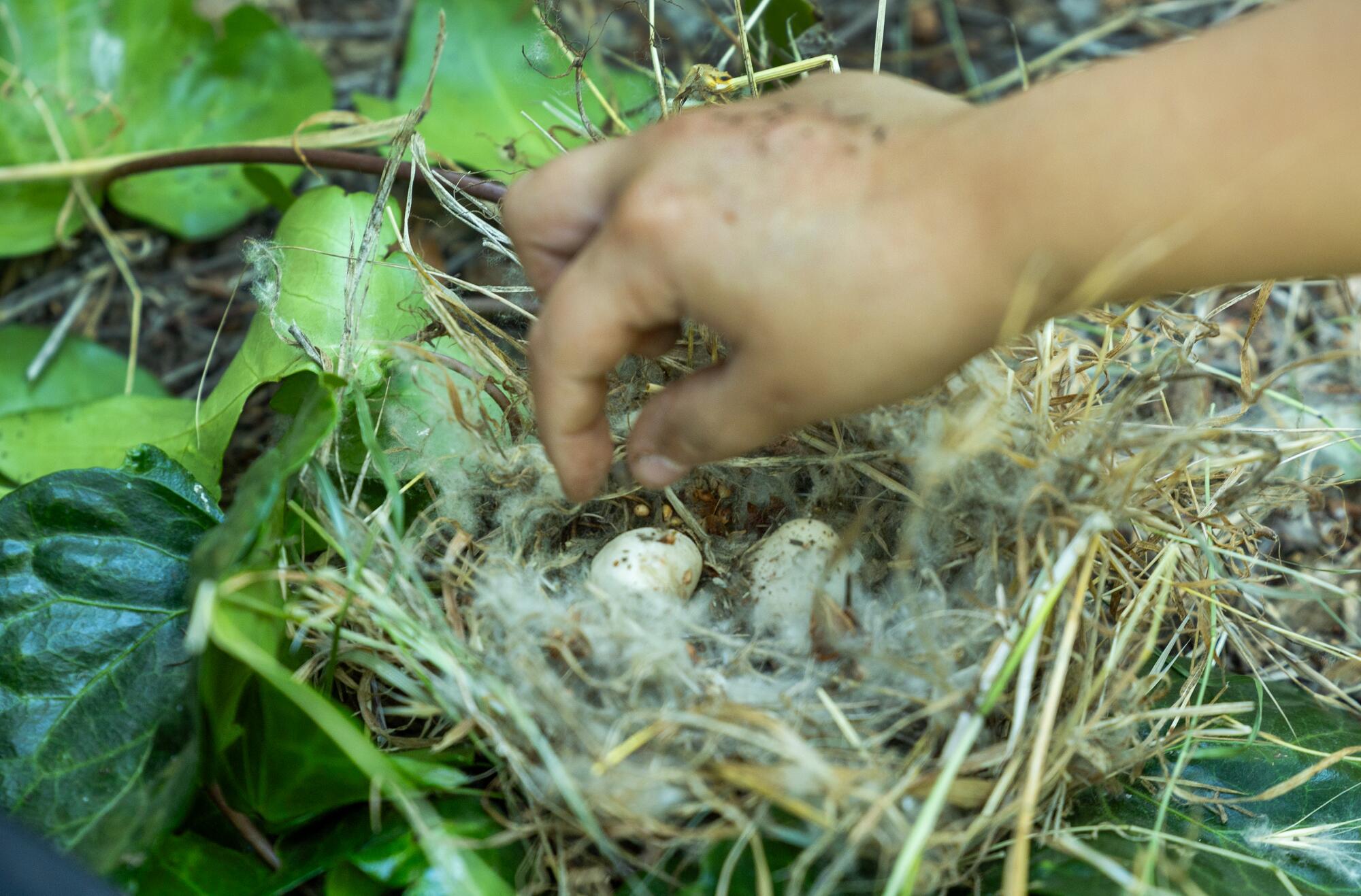
Youngsters use artificial eggs and natural materials to create nests during forest kindergarten summer camp at Earthroots Field School in Silverado Canyon.
(Allen J. Schaben / Los Angeles Times)
Nature-based education — sometimes called forest schools, nature preschools or outdoor kindergartens — is based on a straightforward premise: “that it’s really good to have kids outdoors a goodly chunk of their day,” said David Sobel, professor emeritus at Antioch University New England and author of “Beyond Ecophobia: Reclaiming the Heart in Nature Education.”
Indeed, researchers have found nature-based learning supports creativity, resiliency, executive function, school readiness and a host of other benefits for the body and mind.
Scandinavia-originated forest schools arrived in the U.S. in the 1960s and are part of the broader nature-based education movement. In recent years, the concept has exploded amid worries about children getting lost in the virtual world and the country’s youth mental health crisis. The pandemic turbocharged the trend, as schools closed and parents sought safe learning environments for their preschoolers.
As of the last school year, there were about 800 nature preschools in the U.S., a 200% increase since 2017, according to a survey by the nonprofit Natural Start Alliance, which supports access to nature-based early childhood education. California is among the top three states with the highest number of schools, which primarily serve children ages 3 to 5.
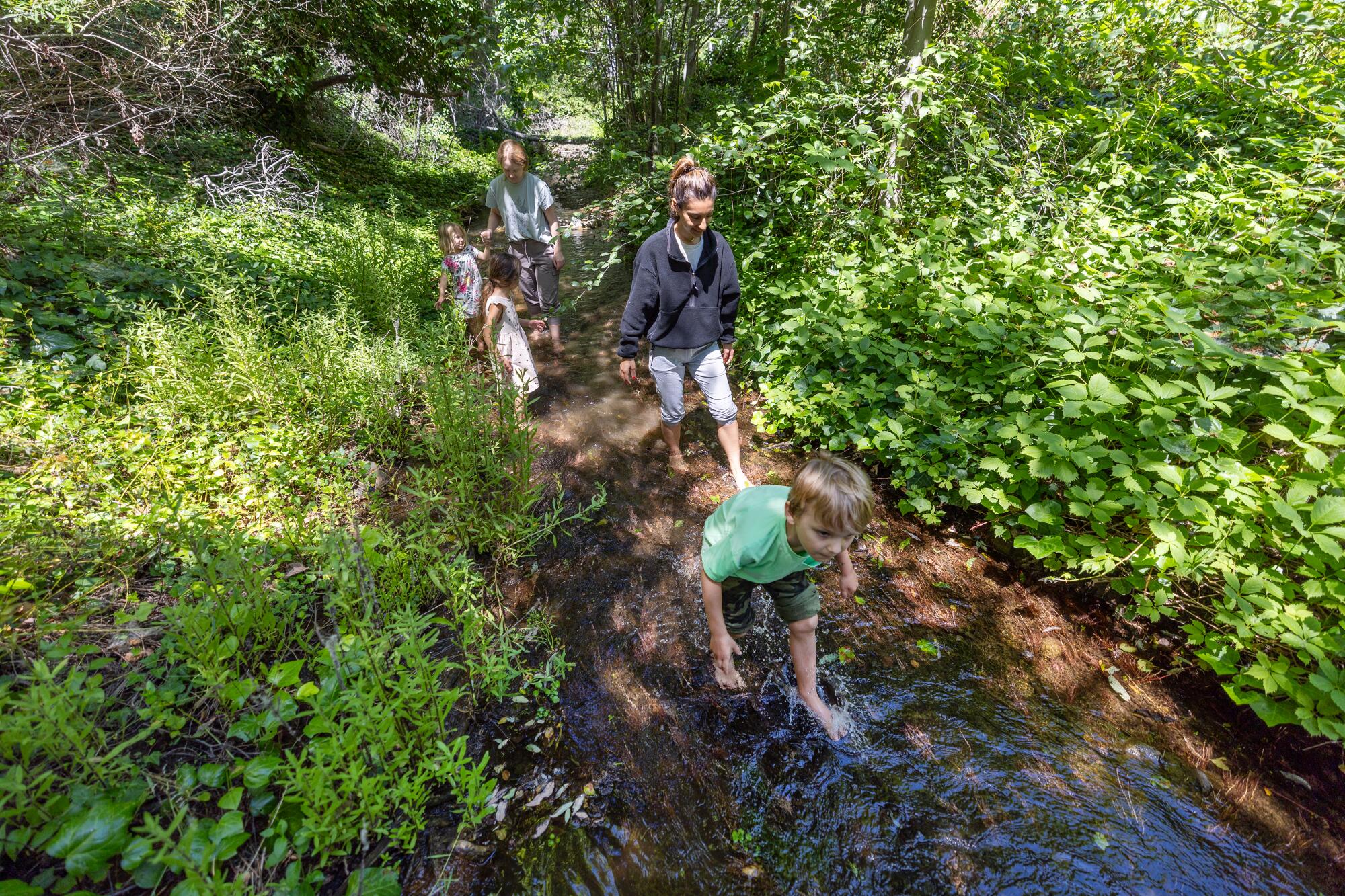
Children and parents explore a creek on a temperate summer day during forest kindergarten camp at Big Oak Canyon, a 39-acre property that serves as home base for Earthroots Field School.
(Allen J. Schaben / Los Angeles Times)
Proponents say children immersed in nature are happier and healthier — and may be poised to become the next generation of climate warriors. An early connection to nature can plant the seeds for its stewardship.
“We only protect that which we love,” said Lia Grippo, president of the California Assn. of Forest Schools. “If we want children to grow into adults who can carry the burdens, honestly, we and previous generations have created for them, then they have to be in love with the land they live on.”

While the movement is suffused with optimism — as growth shows no sign of slowing down — there are challenges.
A large number of programs are unlicensed and therefore unable to tap public funding, prompting criticism that they’re only accessible to wealthy families who can pay tuition, and the movement is contending with a stark lack of diversity that hasn’t meaningfully improved even as programs multiplied.
According to Alliance’s recent survey, white children made up 78% of the student bodies of nature preschools, compared with roughly 47% of the U.S population. Latino and Black children are underrepresented relative to the broader population. (Addressing racial disparities is top of mind for many nature educators, and this past year saw the creation of the Black Educator Network, an Alliance-affiliated professional community for Black educators in nature-based early education.)
Many of the programs are geared toward preschoolers, in part because of a desire to front-load a child’s life with meaningful experiences in nature. Another reason is early education tends to be more flexible than grade school in terms of structure and regulation, or as Sobel puts it: It’s “less riddled with academic expectations so it’s a place where the innovation could happen easier.”
Many programs strive to develop environmental literacy, which can broadly be defined as understanding and caring about environmental issues and having the skills needed to work toward solving them. But how do teachers start molding preschoolers into model environmental citizens?
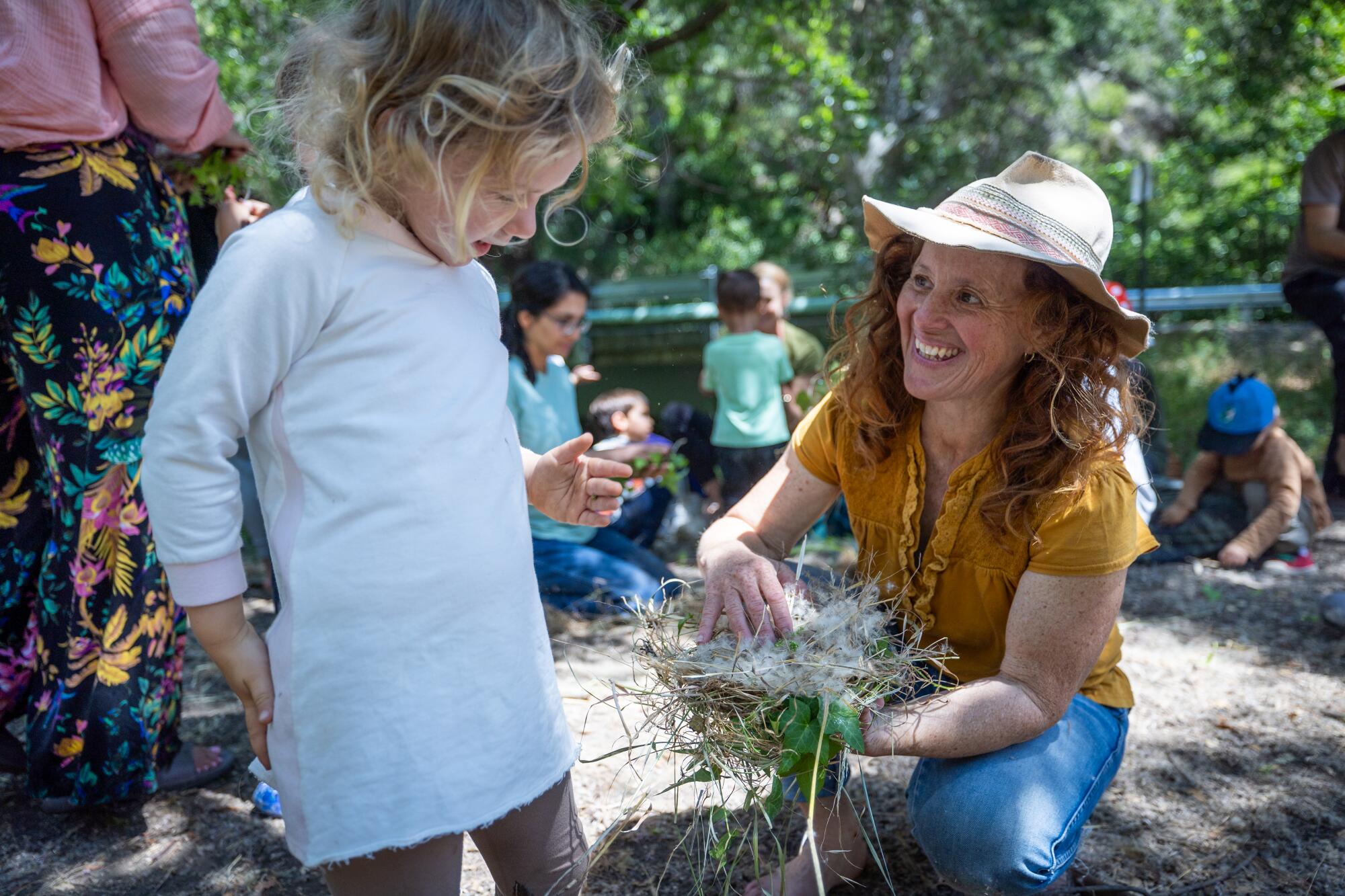
Jodi Levine, executive director of Earthroots Field School, helps a summer camp attendee make a nest.
(Allen J. Schaben / Los Angeles Times)
Jodi Levine, executive director of Earthroots, said the teachers don’t directly discuss climate change with their very young learners. Creating lessons that help kids “fall in love with nature” is “all that they need to understand the beauty of it and the value so that it’s not destroyed,” she said.
Becca Hackett-Levy, founder and director of Northeast L.A. Forest School, said learning about climate change “can start the day they come out of the womb.” It’s not about discussing the science or overarching concepts, but “about being present in nature and seeing what we as humans are doing.”
Children also experience it firsthand. Last year, a brush fire forced a group to evacuate from Elysian Park. Ash rained down as the children were asked to share what they felt, saw, heard, tasted and smelled. Hackett-Levy said it was a concrete lesson about a warming climate colliding with dry invasive grasses.
Fabienne Hadorn, co-founder of the Arroyo Nature School, which operates outdoors in a public park in Pasadena, said the topic sometimes comes up as children ask questions and make observations. The discussions don’t involve the term “climate change,” but center on the impacts — such as cars causing damage to the air. The emphasis is often on the need to take care of the planet.
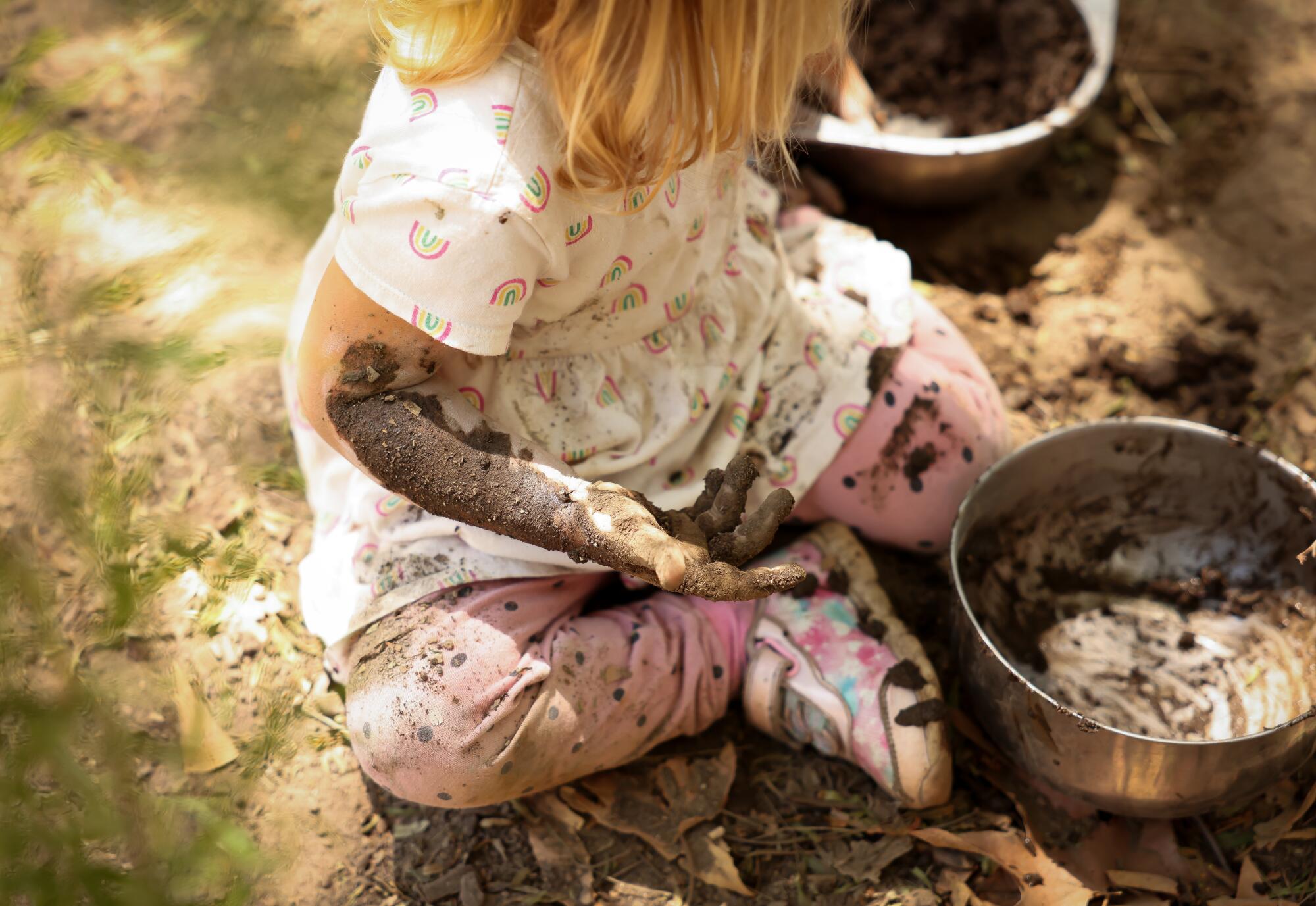
Scout, 2, plays in the mud kitchen at Arroyo Nature School. She made several delicious “cakes.”
(Christina House / Los Angeles Times)
Talking about climate change can be stressful, but not all stress is equal, according to Rahil Briggs, national director of Zero to Three’s HealthySteps, a pediatric primary care program. If a child is in a stable, safe and nurturing environment, they can experience “positive stress.” A small amount of motivating anxiety, she said, is helpful for learning new skills. It can be felt while learning to cross a stream or discussing the environment in a developmentally appropriate way.

While California education officials have championed environmental literacy for students, foundational elements of nature school can put it at odds with public education and regulatory norms.
Nature schools, for example, typically embrace managed risk. Many in the movement see exposing kids to experiences such as climbing a tree as key to developing the resiliency needed to withstand future stressors.
Hadorn said her staff may offer guidance as the children climb trees, advising where to put their foot, or catch them if they falter, but the youngsters lead the charge. “We make sure a teacher at every moment is there if they want to climb,” she added.
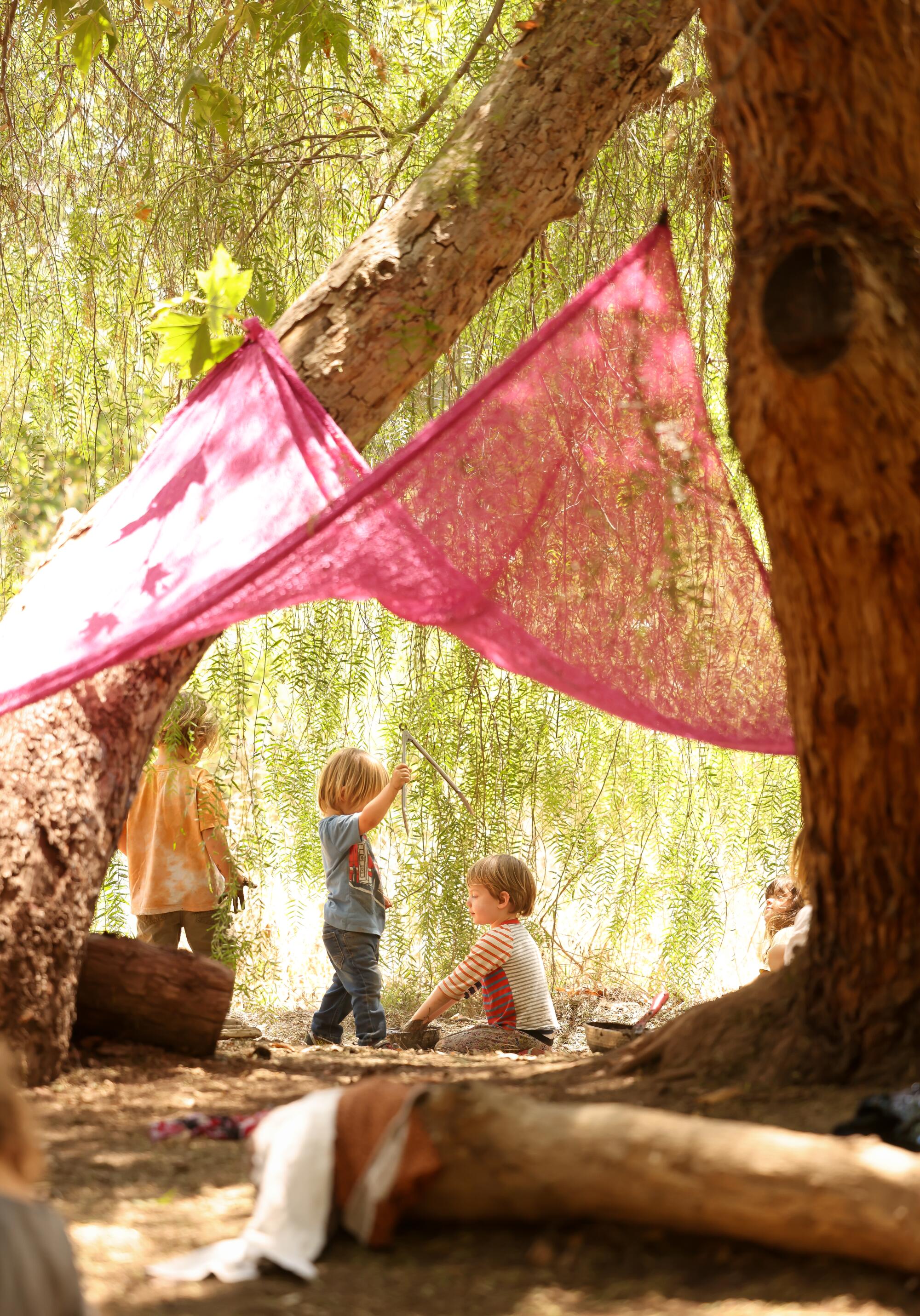
Children play beneath the trees on a warm summer day at Arroyo Nature School.
(Christina House / Los Angeles Times)
Operating outside can also create tension with public land managers. Levine said she was kicked out of two parks as she learned to navigate the rules — including the requirement that visitors stay on paths. “We know better now,” she said, and students are taught to respect the rules of places they go. (Eventually the school acquired a property in Silverado Canyon.)
Hadorn said she moved locations in Lower Arroyo Park after officials tried to charge her a fee associated with renting out a specific area of the park — a category she doesn’t think applies to her roving band of children. She said she has a good relationship with the rangers and always makes sure the area is left in pristine condition.
Hackett-Levy approached L.A. city park officials and worked out an agreement to hold classes in Elysian and Griffith parks. Previously, she’d sometimes try to nab a first-come, first-served area, but would find herself scrambling if someone else had gotten there first.
According to the survey by Natural Start Alliance, 42% of nature schools are not licensed. The percentage is much smaller for programs that are based entirely outdoors, and, according to state regulators, there are none in California.
Kit Harrington, Alliance’s senior policy advisor, said these schools often operate for fewer hours or with fewer children than required for licensing, or are otherwise exempt. Being unlicensed “could imply that something should be licensed but isn’t (as in an unlicensed doctor, for example),” she said in an email. “In the case of these programs, they are primarily operating in ways that don’t require them to be licensed.”
In many states, fully outdoor schools aren’t eligible for licensing. California regulators indicated it’s a gray area and there does not appear to be an effort to clarify the rules or develop new ones.
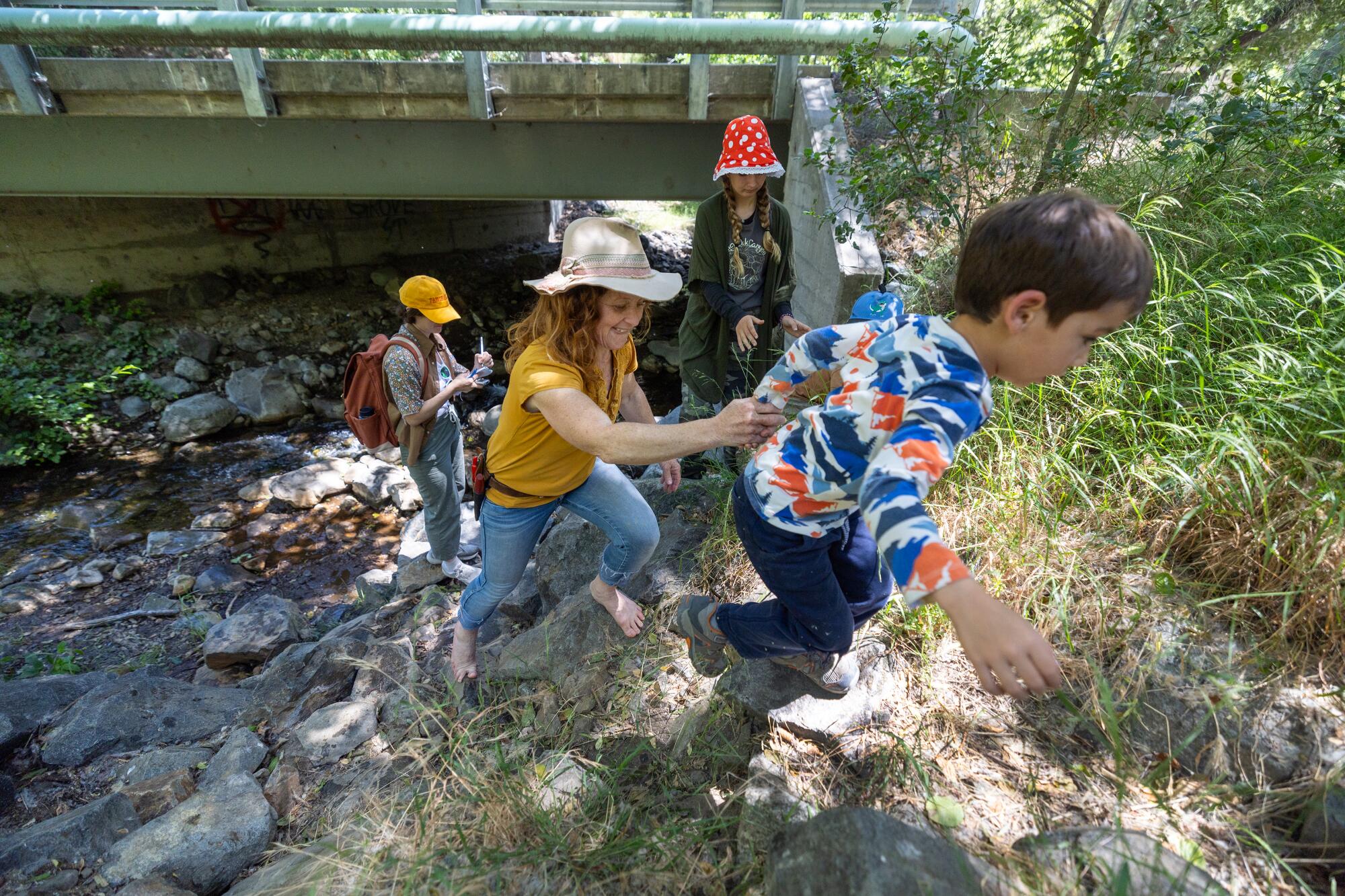
Earthroots Field School’s Jodi Levine helps children up a bank after checking out a creek.
(Allen J. Schaben / Los Angeles Times)
Some nature educators want a path to licensing, but others fear regulations will undercut the spirit of the programs.
Hadorn wonders what might become of tree climbing. Would they set a height limit? She acknowledges that there are upsides, however, such as providing security for parents.
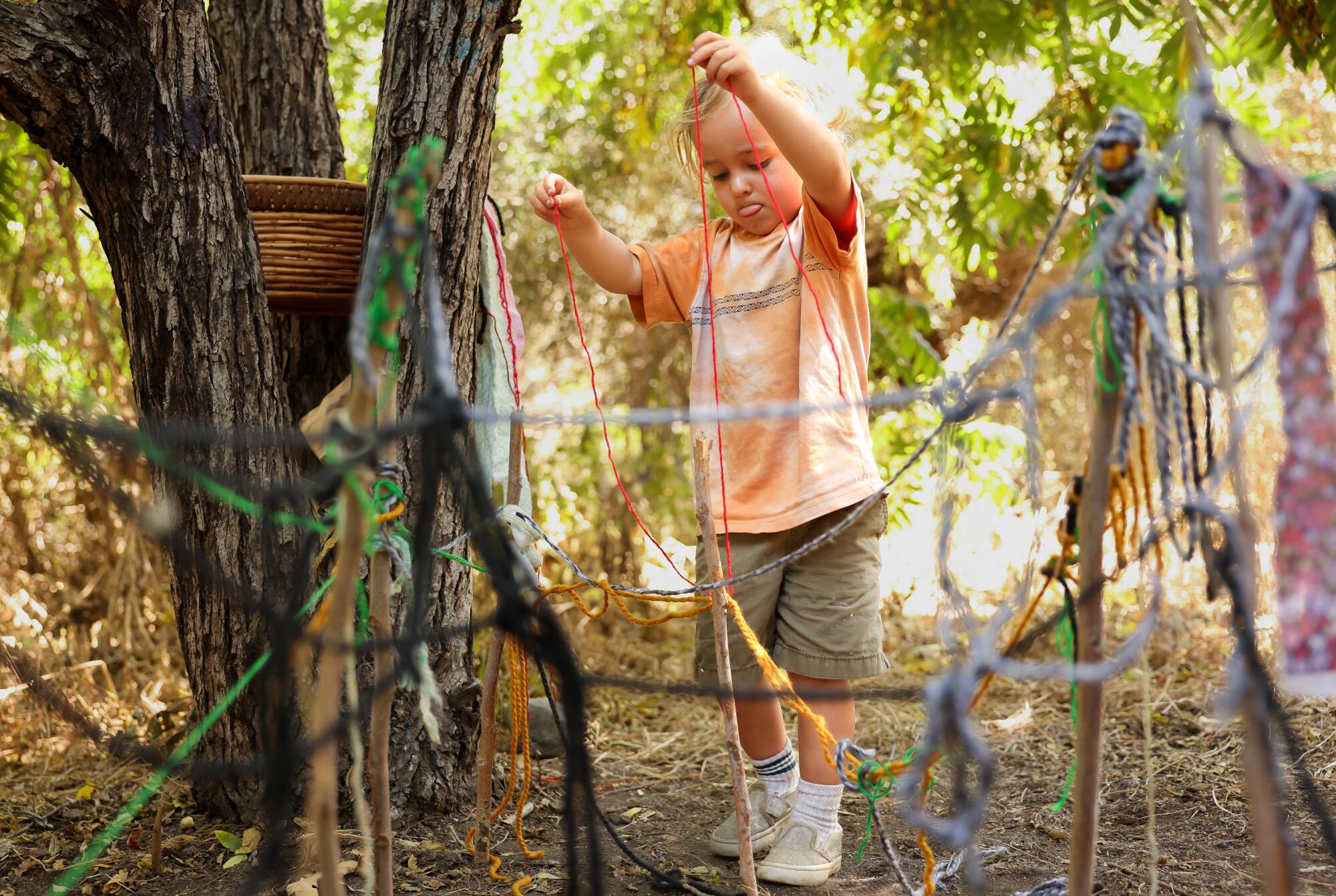
Zoli, 4, plays with yarn and sticks at Arroyo Nature School.
(Christina House / Los Angeles Times)
There’s also concern that the landscape — the primary classroom for nature schools — is becoming less safe for youngsters. Extreme phenomena are challenging nature schools’ emphasis on withstanding the elements by simply wearing the right gear. California — touted as a great backdrop for outdoor education because of its frequent bluebird days — is experiencing increasingly fierce wildfires and punishing heat.
The elements disproportionately affect young children, whose smaller bodies absorb “more of the bad stuff,” said Briggs, who is also a clinical professor of pediatrics, psychiatry and behavioral sciences at the Albert Einstein College of Medicine in New York.

As the climate and regulatory landscape evolves, nature continues to teach.
On a recent scorching day, the cascading branches of a California peppertree enveloped a dozen children attending Arroyo Nature School. Hours passed without a phone in sight. Leo, Zoli and Francis wrapped yarn around sticks to create a makeshift jail. Desmond worked water into clay. Asa and Mylo read books about bugs and cars.
Scout brought over a fresh-baked cake to sample. The secret ingredient? Mud.
The gloopy stuff clung to the 2-year-old’s arms like organic opera gloves. It threatened to sully her white dress flecked with rainbows.
She didn’t mind.

Lifestyle
Sunday Puzzle: BE-D with two words

On-air challenge
Every answer today is a familiar two-word phrase or name in which the first word starts BE- and the second word start D- (as in “bed”). (Ex. Sauce often served with tortilla chips –> BEAN DIP)
1. Sinuous Mideast entertainer who may have a navel decoration
2. Oscar category won multiple times by Frank Capra and Steven Spielberg
3. While it’s still light at the end of the day
4. Obstruction in a stream made by animals that gnaw
5. Actress who starred in “Now, Voyager” and “Whatever Happened to Baby Jane?”
6. Two-time Conservative prime minister of Great Britain in the 19th century
7. Italian for “beautiful woman”
8. Patron at an Oktoberfest, e.g.
9. Dim sum dish made with ground meat and fillings wrapped in a wonton and steamed
10. [Fill in the blank:] Something that is past its prime has seen ___
11. Like the engine room and sleeping quarters on a ship
Last week’s challenge
Last week’s challenge came from Robert Flood, of Allen, Texas. Name a famous female singer of the past (five letters in the first name, seven letters in the last name). Remove the last letter of her first name and you can rearrange all the remaining letters to name the capital of a country (six letters) and a food product that its nation is famous for (five letters).
Challenge answer
Sarah Vaughan, Havana, Sugar.
Winner
Josh McIntyre of Raleigh, N.C.
This week’s challenge (something different)
I was at a library. On the shelf was a volume whose spine said “OUT TO SEA.” When I opened the volume, I found the contents has nothing to do with sailing or the sea in any sense. It wasn’t a book of fiction either. What was in the volume?
If you know the answer to the challenge, submit it below by Wednesday, December 24 at 3 p.m. ET. Listeners whose answers are selected win a chance to play the on-air puzzle.
Lifestyle
JoJo Siwa’s Boyfriend Chris Hughes Says He Plans to Propose When Least Expected

JoJo Siwa
Boyfriend Chris Hughes Reveals Engagement Plans …
Gotta Take Her By Surprise!!!
Published
JoJo Siwa and her man Chris Hughes have clearly discussed engagement details … because Hughes dished on a few specifics about a potential proposal.
The singer and beau gave The Sun an update on their relationship Sunday … and, the conversation turned to all things engagement — including the right and wrong time to pop the question.
Waiting for your permission to load the Instagram Media.
In the clip, Hughes says he’s against getting engaged on an obvious milestone day like Christmas for example … claiming it takes away the surprise from the proposal.
JS seemed into the idea … joking that Chris is trying to keep her guessing — though she did give it some thought before stamping the idea with a seal of approval.
However, one nontraditional engagement practice the two won’t participate in is Siwa popping the question to Hughes … because he says he wants to buy the ring and ask her to marry him.
JoJo won’t wait forever though … telling Hughes he’s got seven years to ask her — or she’ll ask him. Clock’s ticking down to 2032!
Anyhoo … keep your head on a swivel, JoJo — because a surprise engagement could be right around the corner!
Lifestyle
When a loved one dies, where do they go? A new kids’ book suggests ‘They Walk On’

Rafael López / Roaring Brook Press
A couple of years ago, after his mom died, Fry Bread author Kevin Maillard found himself wondering, “but where did she go?”
“I was really thinking about this a lot when I was cleaning her house out,” Maillard remembers. “She has all of her objects there and there’s like hair that’s still in the brush or there is an impression of her lipstick on a glass.” It was almost like she was there and gone at the same time.
Maillard found it confusing, so he decided to write about it. His new children’s book is And They Walk On, about a little boy whose grandma has died. “When someone walks on, where do they go?” The little boy wonders. “Did they go to the market to thump green melons and sail shopping carts in the sea of aisles? Perhaps they’re in the garden watering a jungle of herbs or turning saplings into great sequoias.”

Rafael López / Roaring Brook Press
Maillard grew up in Oklahoma. His mother was an enrolled member of the Seminole Nation. He says many people in native communities use the phrase “walked on” when someone dies. It’s a different way of thinking about death. “It’s still sad,” Maillard says, “but then you can also see their continuing influence on everything you do, even when they’re not around.”
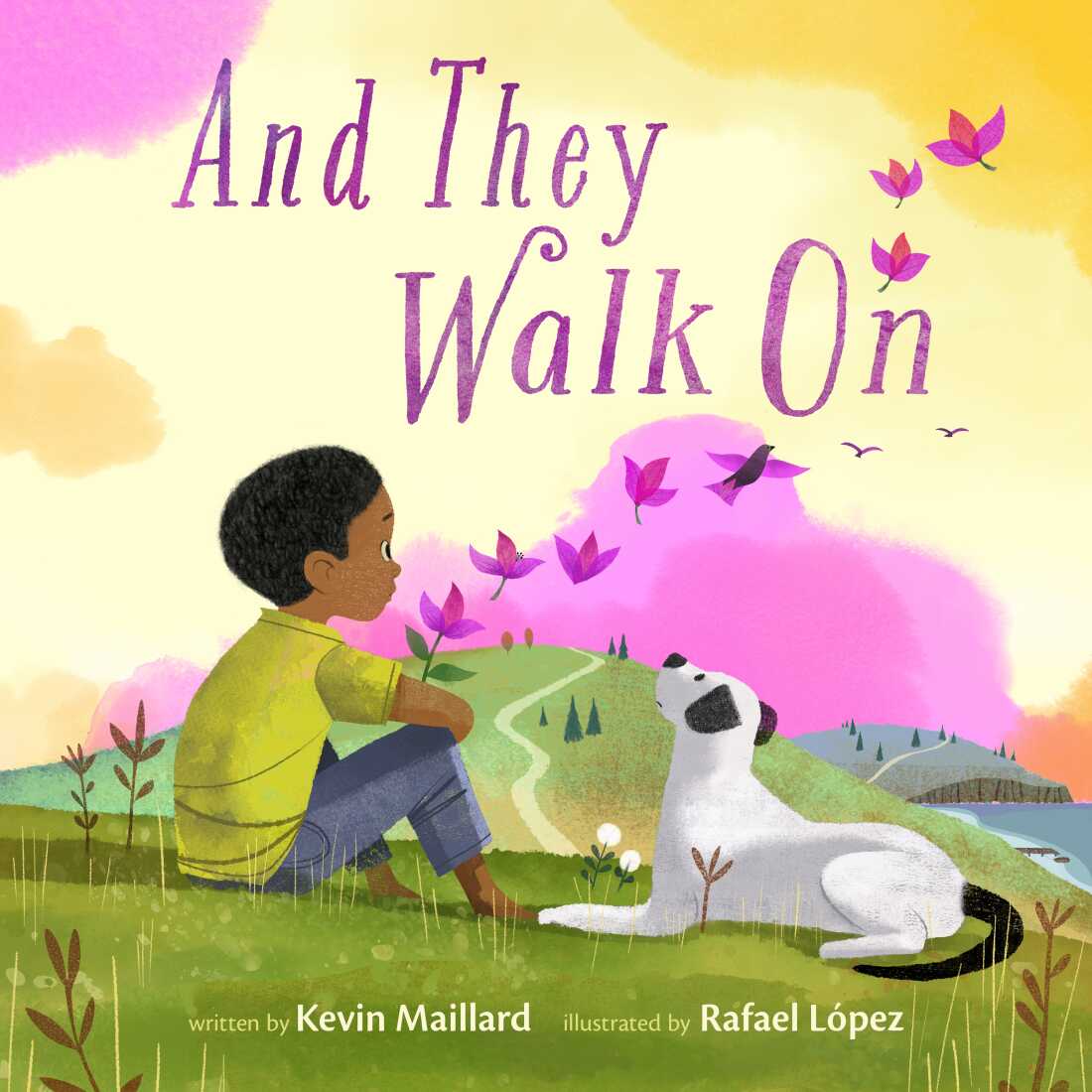
Rafael López / Roaring Brook Press
And They Walk On was illustrated by Mexican artist Rafael López, who connected to the story on a cultural and personal level. “‘Walking on’ reminds me so much of the Day of the Dead,” says López, who lost his dad 35 years ago. “My mom continues to celebrate my dad. We talk about something funny that he said. We play his favorite music. So he walks with us every day, wherever we go.”
It was López who decided that the story would be about a little boy: a young Kevin Maillard. “I thought, we need to have Kevin because, you know, he’s pretty darn cute,” he explains. López began the illustrations with pencil sketches and worked digitally, but he created all of the textures by hand. “I use acrylics and I use watercolors and I use ink. And then I distressed the textures with rags and rollers and, you know, dried out brushes,” he says. “I look for the harshest brush that I neglected to clean, and I decide this is going to be the perfect tool to create this rock.”
The illustrations at the beginning of the story are very muted, with neutral colors. Then, as the little boy starts to remember his grandmother, the colors become brighter and more vivid, with lots of purples and lavender. “In Mexico we celebrate things very much with color,” López explains, “whether you’re eating very colorful food or you’re buying a very colorful dress or you go to the market, the color explodes in your face. So I think we use color a lot to express our emotions.”

Rafael López / Roaring Brook Press
On one page, the little boy and his parents are packing up the grandmother’s house. The scene is very earthy and green-toned except for grandma’s brightly-colored apron, hanging on a hook in the kitchen. “I want people to start noticing those things,” says López, “to really think about what color means and where he is finding this connection with grandma.”
Kevin Maillard says when he first got the book in the mail, he couldn’t open it for two months. “I couldn’t look at it,” he says, voice breaking. What surprised him, he said, was how much warmth Raphael López’s illustrations brought to the subject of death. “He’s very magical realist in his illustrations,” explains Maillard. And the illustrations, if not exactly joyful, are fanciful and almost playful. And they offer hope. “There’s this promise that these people, they don’t go away,” says Maillard. “They’re still with us… and we can see that their lives had meaning because they touched another person.”

Rafael López / Roaring Brook Press
-

 Iowa7 days ago
Iowa7 days agoAddy Brown motivated to step up in Audi Crooks’ absence vs. UNI
-

 Iowa1 week ago
Iowa1 week agoHow much snow did Iowa get? See Iowa’s latest snowfall totals
-

 Maine5 days ago
Maine5 days agoElementary-aged student killed in school bus crash in southern Maine
-

 Maryland7 days ago
Maryland7 days agoFrigid temperatures to start the week in Maryland
-

 South Dakota1 week ago
South Dakota1 week agoNature: Snow in South Dakota
-

 New Mexico5 days ago
New Mexico5 days agoFamily clarifies why they believe missing New Mexico man is dead
-

 Detroit, MI6 days ago
Detroit, MI6 days ago‘Love being a pedo’: Metro Detroit doctor, attorney, therapist accused in web of child porn chats
-

 Education1 week ago
Education1 week agoOpinion | America’s Military Needs a Culture Shift


















